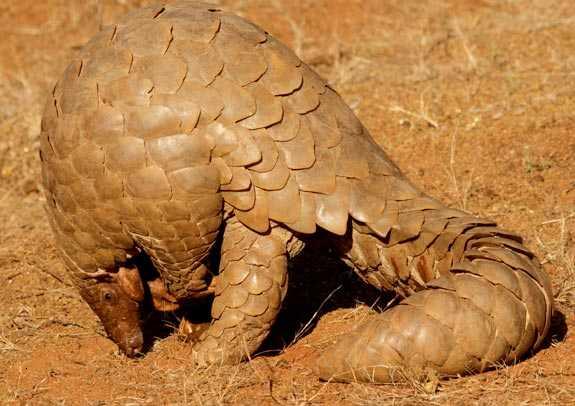The Indian Pangolin (Manis crassicaudata), also called thick-tailed pangolin and scaly anteater is a pangolin native to the Indian subcontinent.
It is easily recognised by its overlapping scales that acts as an armor for its body.
This article will further give details about the Snow Leopard within the context of the IAS Exam
Characteristics of a Pangolin
The scales of a pangolin are aries depending on the colour of its environment. It feeds on primarily insects (insectivore) eating ants and termites, digging them out of mounds and logs. It is active during night and it rests in deep burrows during daytime
Lacking any teeth, the pangolin relies on its tongue to feed itself, relying on its strong stomach to aid in its digestion. Its characteristic scales covers its upper face and body excluding the belly and inside of the legs
Further characteristics of the Pangolin are given as follows:
Characteristics of an Indian Pangolin
| Head to Tail Length | 84–122 cm |
| Weight | 10–16 kg |
| Tail Length | 33–47 cm |
| Number of Scales | 160–200 |
| Latin Name | Manis crassicaudata |
| Habitat | India and parts of Sri Lanka |
For more about species in news, visit the linked article.

Behaviour and Habitat of Indian Pangolin
The Indian Pangolin has been found in various types of forests including Sri Lankan rainforests and in hills. It inhabits grasslands and secondary forests and also can survive in dry and desert regions.
The pangolin has two types of burrows:
- Feeding burrows
- Living burrows
Feeding burrows are smaller in size and are found mostly in the spring season when prey for the pangolin is available in greater concentrations.
Burrows of living are large in space and will be used by the pangolin longer in comparison to its feeding counterparts. It is used to sleep and rest during daytime
The pangolin uses its specially adapted long, sticky tongue through which it is able to feed on a variety of insects
Conservation of the Indian Pangolin
The Indian pangolin is listed on CITES Appendix I since January 2017 and is protected in all range countries.
As per the IUCN Red List the Indian Pangolin is listed as ‘Endangered.’
The Indian Pangolin is hunted for its meat and scale both consumed locally and internationally. Its parts are used as food and medicine
Along with being made as an aphrodisiac, it is also used to make charms or bone jewelry. The leather is used to make footwear and other leather goods. The majority of hunting is carried out by locals or professional hunters. They are also threatened by deforestation and habitat loss.
Frequently asked Questions Related to Pangolin
What are Pangolin scales made of?
Why are Pangolins the most trafficked animal in the world?
Is Pangolin trafficking illegal in China?
For more information about upcoming Government Exams, visit the linked article. More exam-related preparation materials will be found through the links given below:
Related Links
Comments